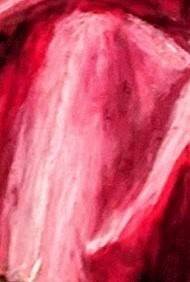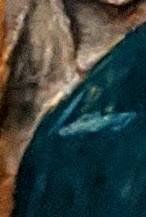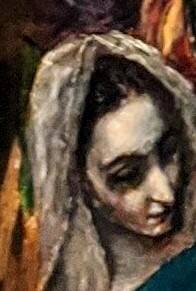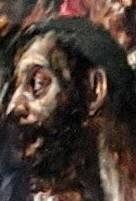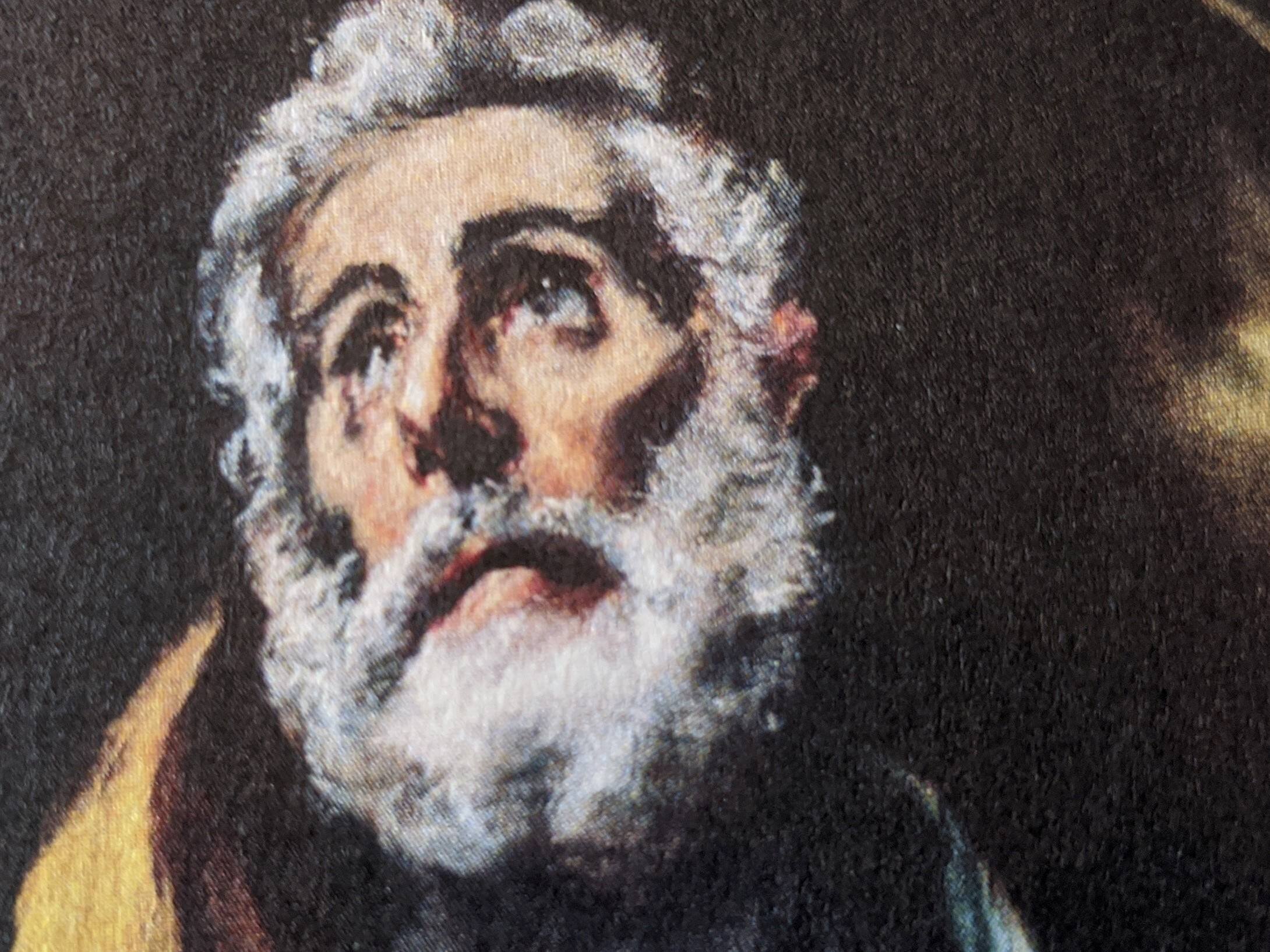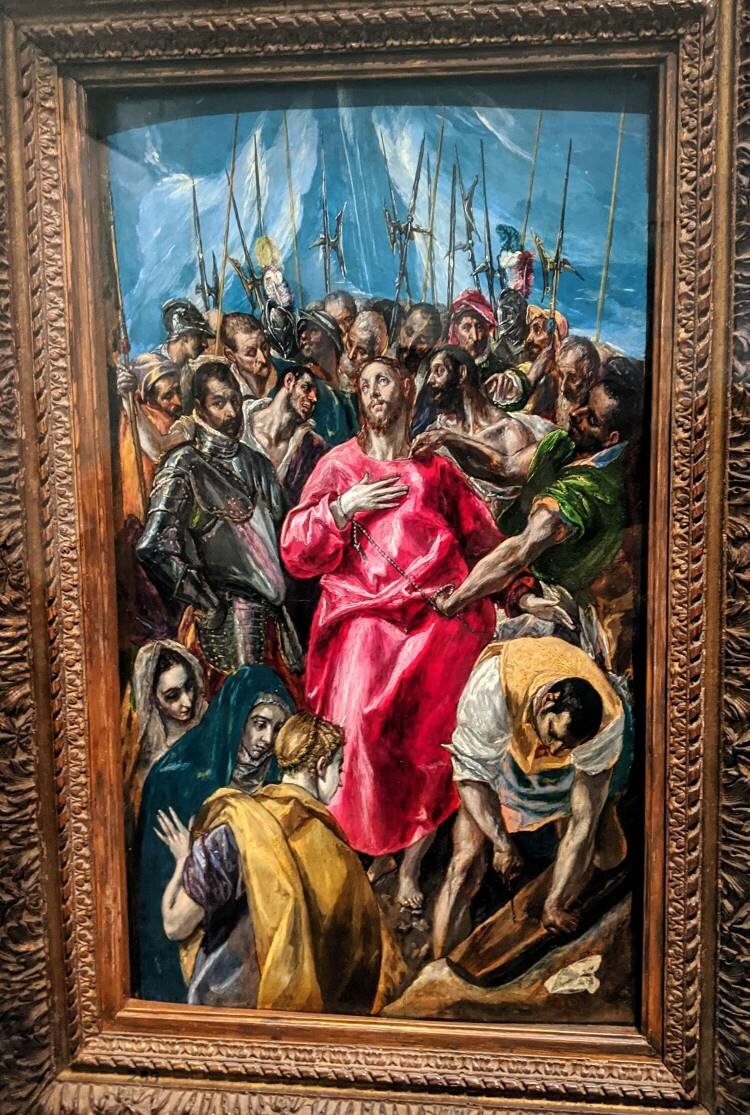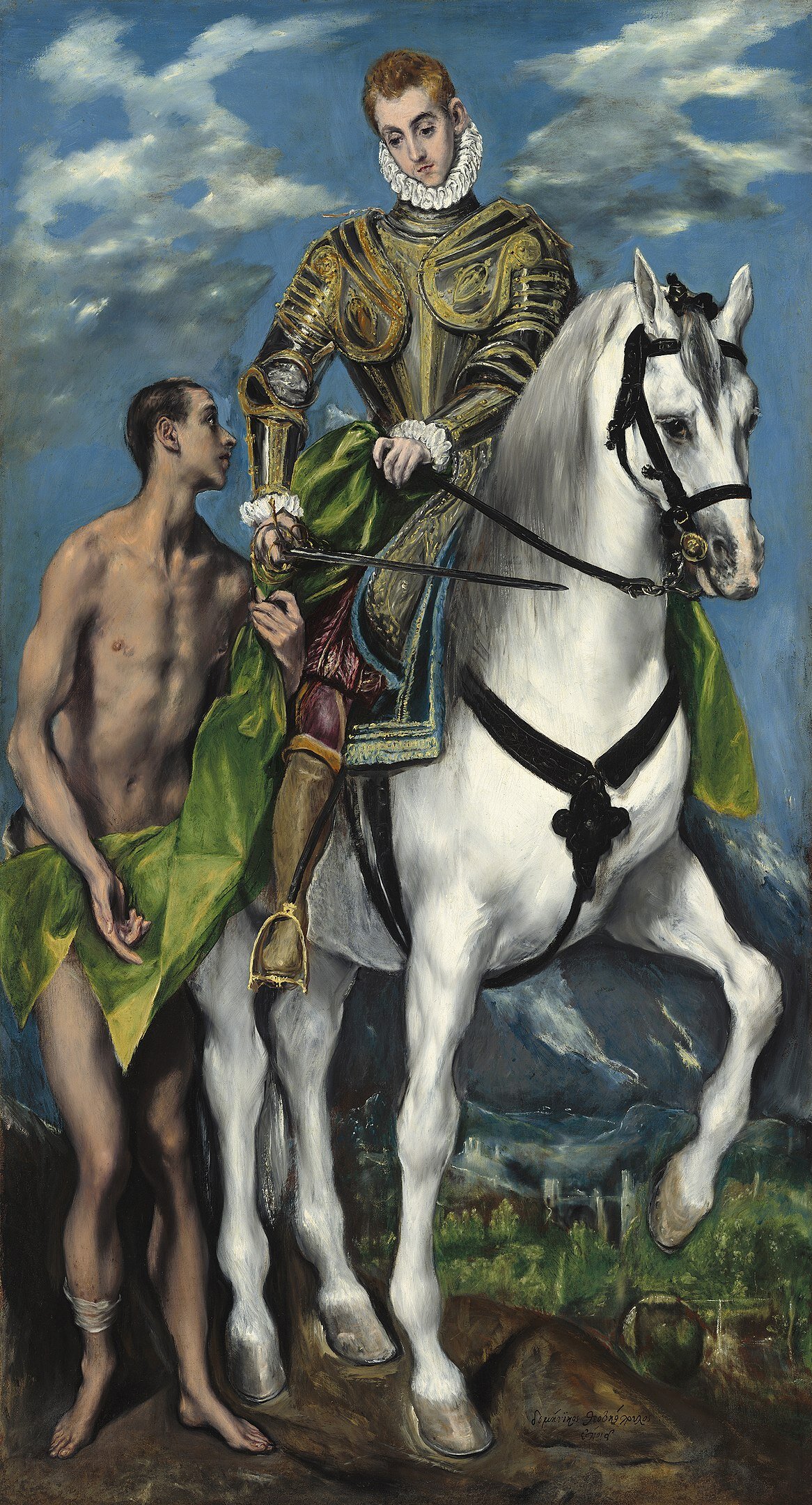Petruschki's Journey into the Blue - Chapter 13 - El Greco - Crackling Colors and the Celebration of the Vertical
Für die deutsche Version des Blogposts bitte HIER klicken
In December 2019 we went on a journey by bus and train through Spain, France, Germany, Belgium, Great Britain and Ireland. The final destination was the exhibition Protest! by Derek Jarman in Dublin and there was so much to see on the way there. We visited 21 exhibitions and discovered many stories. More about this in Chapter 1 Dreaming into the Blue. We are still at the very beginning of our trip in Paris. Here we visit the exhibition Greco in the Grand Palais. For the next chapter of Greco click here The Green between heaven and earth, you see the third chapter here: The long limbs dance in light and shadow.
After a walk along the Seine in golden light, we arrive at the Grand Palais. Endless gates are supposed to channel the onslaught of people who want to see Greco. But there are no crowds. Everything looks pretty empty. The impending general strike has probably prevented many people from traveling to Paris. There are a lot of police with armored cars. We have to circle it three times until we manage to find the access to the empty gate. And with a few others we go and walk the long, empty corridors like lost sheep. Until we stand in front of a nice little man who looks a bit tipsy. We are allowed to enter the exhibition. There are many more people inside than outside. Apparently nobody found the wardrobe. Most of the visitors stand in front of the pictures in thick coats and with large bags. The exhibition space is pretty small. Maybe because only this very small part of the palace has the necessary high rooms for the large-format pictures. No idea ... And because everyone is dressed in thick winter clothes, we move in contradiction between masterpieces full of spiritual splendor and clogged corridors. So unfortunately, some works cannot be viewed from the necessary distance.
The exhibition “Greco” took place from October 18 to February 10, 2020 at the Gran Palais in Paris. Curators of the exhibition: Guillaume Kientz, Curator of European Art, Kimbell Art Museum, Fort Worth and Charlotte Chastel-Rousseau, Curator of Spanish and Portuguese Painting, Department of Paintings, Musée du Louvre.
Many works in this exhibition were not seen in Europe for a long timebecause they belong to museums in the United States.
A large part of the exhibition could be seen until October 2020 at the Art Institute of Chicago, in the exhibition ‘El Greco: Ambition and Defiance’. I like the title. Greco always seemed to be aware of what an extraordinary talent he had. And he defended this talent persistently and proudly. The exhibition can still be visited virtually, there is a video and an audio tour, as well as various articles.
On the cover picture: El Greco Penitent Magdalena 1576-1578
This is one of about 5 paintings by Greco showing repentant Mary Magdalene. Its from Greco early days in Toledo and must have been made between 1576 and 1578. The subject was very popular during the Counter Reformation as a representation of repentance and penitence. 50 years later Artemisia Gentileschi painted completely different Magdalenes. The ‘Magdalena as Melancholy’ looks at the viewer with half-closed eyes, the ‘Magdalena in Ecstasy’ seems to be dreaming voluptuously. If you would like to look at it again, here is the Link. This picture can be seen today in the Budapester Museum of Fine Arts.
Everything shimmers, the eyes gazing towards the sky, the skin, the fabric, the delicate breast that is almost in the center of the picture. Repentance is sensual and delicate and fragile. The wide cloak, the blue of which flows into a pale mauve, reveals the bare shoulder and bosom. The reference to Magdalene as a former prostitute. In the background you can see a cold landscape lit by the moonlight. The sky is partly bright blue, but appears icy together with the white and the dull colors of the landscape. Even the shapes of the clouds, the rocks and the cloth are reminiscent of ice and cold hardness despite their delicacy.
"From the unknown, from the weddings that are celebrated in it and which makes create masterpieces posible, Greco draws the divine decay of his colors, his yellow and his red, which only he alone could sound like the trumpets of angels."
Jean Cocteau
Greco's colors, the long, narrow faces and bodies that stretch upward like plants to the sunlight, the eyes swimming in tears or with feverish look, all of this is to this day incomparable. How much strength did he had to have and how much self-confidence in himself and his art in order to maintain his own way of painting and to be successful with it….
As an artist he could not be classified, but still gained recognition and enough commissions to make a living from it. With his pictures he created something that is spiritual in the broadest sense, independent of religion and church, rather it is about being human, being exposed, longing and suffering, far beyond any fashion or contemporary phenomenon. But after his death he was quickly forgotten and only rediscovered at the beginning of the 20th century.
The hands fascinate me. That is why they appear here as a detail. I think they are beautiful. Beautiful in their movement.
The holy Luke paints an Ikone of the holy virgin with her child, um 1560/67
St. Luke paints an icon of the Virgin and Child
Around 1560/67
This painting is one of the earliest surviving works by El Greco. It was created before El Greco went to Venice, around 1567 in Crete. We see the Evangelist Luke as a painter. According to legend, Luke painted Mary with the child when he saw her in a vision. This made him the patron saint of painters. Lukas was also the patron saint of the painters' guild in Candia, the Cretan hometown of El Greco.
You can see here that Greco soon became interested in Renaissance art. The spatiality is completely different than in an Byzantine icon painting. Although this picture is badly damaged, you can see Greco's great skills as an icon painter in the depiction of the Madonna and Child on the easel.
El Greco, actually Domínikos Theotokópoulos, was born in Crete in 1541. There he trained as an icon painter. A Menegos Theotokópoulos is mentioned as a master of painting as early as 1566. He was probably very successful, as some sources testify that a high price was paid for his pictures early on.
We know from a letter dated August 18, 1568 that he was in Venice. He painted numerous pictures there and approached the Venetian artists Jacopo Bassano, Jacopo Tintoretto and Titian. Instead of the golden background of the icons, he now painted perspective rooms. He also switched from tempera painting to oil painting on canvas. But even until the end of his life he made planed many of his paintings with tempera paints and then executed them with oil paints. Greco's intense colors of the robes, some of which stand almost inharmoniously side by side, and his own design of the light go back to his time in Venice.
Boy lighting a candle Around 1570-1572
Boy lighting a candle Around 1570-1572 Naples, Museo e Gallerie Nazionali
In 1570 his friend, the miniature painter Giulio Clovio, recommended Greco to Alessandro Farnese in Rome, who became his sponsor there and for whom he probably painted this picture “El Pavon”. The painting shows a boy blowing on a piece of glowing coal to light a candle. In Italian art of the 16th century it was not common to depict such everyday scenes. Everyday scenes were placed, if at all in a picture of a saint or in paintings with a religious subject. But to El Greco this scene seemed important enough and it's so beautiful how he works with the light here. How the glowing coal and the already inflamed wick illuminate the child's face in all its seriousness and concentration. Beauty and great vibrancy. Although Greco later mainly painted religious pictures, there is never any reference to religion or belief in his writings. He must also have known about the ancient scholar Pliny the Elder, who described this very scene. Maybe he wanted to show how educated he was. He tried to get a prominent position in Rome.
Portrait of the architect Andrea Palladio 1575-76
What kind of look is that? Fatigue, a certain reserved friendliness and clarity. I look the man in the face and his gaze changes, as if he was telling something at the moment or even communicating with me, the person opposite. His gaze goes inwards as well as outwards. The person depicted here is probably the architect Andrea Palladio. El Greco has been particularly interested in architecture since his time in Italy. In the Farnese Palace in Rome he moved in humanistic and intellectual circles. Many of these people became friends and supporters.
He admired the architect Andrea Palladio. He was the most important architect of the Renaissance in Northern Italy and is considered the first professional architect at all. He was the son of a miller and trained as a stonemason. The poet Trissino recognized his talent and encouraged him. His life's work is amazing. This also includes several books on architecture, some of which are self-illustrated. Maybe that's why I see the tiredness in that look. Building during the day, writing and studing at night.
El Greco Christ Expels the Merchants from the Temple, 1575
Christ Expels the Merchants from the Temple or The Cleansing of the Temple, around 1575, Minneapolis Institute of Art, Minneapolis
In this early work, which he painted in Rome, Greco based himself on Titian and Tintoretto.
Christ driving out the money changers who desecrated the temple in Jerusalem was a popular theme in Counter Reformation art. For the Catholics, it symbolized the purification of the church through internal reforms and the expulsion of Protestant heretics. El Greco uses confusing lines here, the room is designed in a confused way and the light falls quite illogically. This creates an atmosphere of anger and destruction. Here his full signature appears in Greek letters on the step below Christ. In the lower right corner, El Greco portrayed the most important Renaissance artists for him: Titian, Michelangelo, Giulio Clovio (the miniature painter who promoted him) and Raphael.
El Greco, 1610
For comparison, the same subject is painted by El Greco 35 years later. The whole background and the spatial description is much more abstract. Although there are some figures with exactly the same posture, the bodies in the later picture look like they are in movement. Actually there aren't many more figures, but it seems like a mass of bodies. The light is so increased that the colors come out very bright. It already anticipates Expressionism which comes 300 years later.
John 2: 13-16 The Jewish Passover was at hand and Jesus went up to Jerusalem. 14 In the temple he found the cattle, sheep, and pigeon sellers and the money changers sitting there. 15 He made a whip out of ropes, and drove them all out of the temple, including the sheep and cattle; He poured out the money from the changers and knocked over their tables. 16 He said to the pigeon dealers: Get this out of here, don't turn my father's house into a market hall!
Greco The undressing of Christ. El Expolio de Christus 1577-79
285cm X 173cm
Colors Feet Fabrics Hands - Christ's undressing painted for the sacristy of Toledo’s Cathedral, where it still hangs. El Greco traveled to Spain in 1577 and settled in Toledo. His friend Luis de Castilla recommended the painter to his father Diego de Castilla, who was deacon of Toledo’s Cathedral. He got three big jobs from him. In Spain at that time painters were only seen as craftsmen who had to do what the client wanted. But El Greco earned himself respect by simply taking artistic freedom. Not without provoking resistance. He was accused of having chosen a scene for which there is no source in the Bible and that it is inappropriate for there to be faces in the crowd that are placed over the head of Jesus.
It's a story told through faces. We see Jesus in the center of the picture. He looks up at the sky with a slight smile and looks untouchable. As if there was a natural boundary between him and the tormentors. A figure in the back points accusingly at him. Right behind him, two seem to be arguing who can have his clothes. A man dressed in poisonous green is holding Christ on a rope and it looks as if he is feeling the fabric of the tunic. In the lower part of the picture a man dressed in yellow is drilling a hole in a beam. This way, the nail that is driven through the feet of Jesus at the crucifixion is supposed to penetrate more easily. On the right part below we see the three Marys, who are brighter than the other figures. They are illuminated by the shining Christ. The face of Jesus is enlightened and its transfigured and calm expression contrasts with the agitation and aggression of the faces around him. The robe is painted in bright crimson. The blue and yellow in the lower part and the blue of the sky underline the power of this red. The folds and the treatment of the incident light are masterfull. El Greco created a connection between the anti-naturalism of Byzantine painting and the Venetian color scheme and mannerism.
Here is a Video about the restoration of this picture.
Greco Assumption of Mary 1577-79
And there are those incredible colors again. This inherent materiality (or texture) of the garments. The angels look like their clothes are made of dragonfly wings. The picture is almost 4 meters high and more than 2 meters wide. What dimensions! From the very bottom you look up at Maria, who is floating up on a crescent moon. But this levitation looks like it has speed. Mary is supported and fluttered around by angels. The disciples, gathered around her grave, look up at her aghast and in disbelief. Breathtaking, the view upwards, the perspective broken and reconnected by the red and azure blue colored surfaces. El Greco's brushstroke is strong and shows his great confidence. This can also be seen in his signature, which is relatively large in the lower right corner and painted as if it were attached to the surface of the picture.
Up until that point there was no altarpiece in Spain that was conceived in this way.
Greco Adoration of the name of Jesus (dream of Philip II) 1578-79
Adoration of the name of Jesus (dream of Philip II) Around 1577/80
Real Monasterio de San Lorenzo de El Escorial
This painting was created by El Greco for King Philip II. The painting's usual title is "The Adoration of the Name of Jesus." At the very top in the middle, the letters IHS, the monogram of Christ, appear between the clouds. The Nomen Sacrum IHS is derived from the first three letters of the name Jesus in Greek capital letters, Ι Η Σ Ο Υ Σ, where the sigma is replaced by a Latin S. In black clothes you can see the kneeling King Philip II in the foreground. In the upper half the angels fly around the name of Christ. Bright blue, yellow, red and again the transparent gauze of the dragonfly wings. They have attentive, friendly, beautiful faces. In the lower half a kind of last judgment rages. Many believers worship the name of Christ far away. On the far right we see the gate to hell, or better said the hellhole, a merciless shark's mouth or drooling mouth of the hellhound into which the unbelievers are sucked. And although I can still see two scraps of blue there, they are all very quickly naked and than only skeletons. In the middle of the lower half we see a kind of blood stream into which the unbelievers or the sinners are thrown. The king finds himself between important churchmen, he is portrayed as a fighter of the Counter Reformation and as the custodian of the Catholic Church.
But it seems the king did not like the picture, he only gave El Greco one more commission.
Red hands ... I wondered what that was supposed to mean. I later learned that bishops wear red gloves and shoes to symbolize the wounds of Christ. There is a ring over the glove.
And then there are those feet in heaven. I don't know why they fascinate me so much. Those flying soles in the air. And although the colors are crazy, surreal, these fluttering angel's feet seem so touchable and contemporary, so to speak, very down to earth. And even a little dirty.
Greco The Adoration of the Shepherds 1579
“The Adoration of the Shepherds” from Fondación Botin is considered one of the surprises of the Paris exhibition.
First I noticed Hieronymus in the foreground, who looks at the viewer a little darkly and accompanies the happy event on the home organ. The organ is actually a book, Saint Jerome was fabulously educated and has written several books. He appears here because the Church Father lived in Bethlehem for 34 years and translated large parts of the Old Testament there. It is a strange figure who shows no joy at all about the birth of the baby Jesus. Perhaps because the time traveler from AD 400 knew how the whole story would end, 33 years later, with nails on the cross. The two classically dressed women are also unusual in this scene. In this painting El Greco refers to the pseudo Mathäus Gospel. Like with these two midwives who are waiting at the entrance of the crib / cave because the sheen is too big. The crescent moon above them symbolizes Mary's virginity before and after childbirth. And ox and donkey with their shepherds are there. The cloud with the little swirling angels is also strange. The gauze up there on the ceiling looks as amorphous as some strange living being. These deep sea fish that are completely transparent through the darkness. I think it's pulsating. And sends out light. Yellow-tinged red of the tunic of Jerome and the blue-tinged red of the dress of Mary ..
Greco The Adoration of the Shepherds
This picture was not in the exhibition. But I find the comparison fascinating. This version of the Adoration of the Shepherds is believed to be El Greco's last work. He had started it in 1612 and finished it shortly before his death. It was meant to hang over his own grave. The bodies are severely distorted. The contrast between light and dark is dramatic. Everything is in motion, as if the figures were turning around the Christ child giving light.
St Veronica with the Holy Shroud Toledo 1580
Veronica , 1580, Toledo
Incredible these two faces side by side. The direct gaze of Christ and the ethereal face of Veronica, who looks in a different direction. According to legend, Veronica wiped the sweat from Christs face on the way to Golgotha, after which his facial features could be seen on the cloth. Veronica's handkerchief is kept as a relic in the Vatican. El Greco resounds the levels here: Veronica is much more intangible and much more spiritual, while Christ looks out of the picture in three dimensions, as if he were addressing the viewer right away.
For many centuries people asked themselves with varying urgency, whether a human should create an image of God's son, or it he even could at all. From the 6th century onwards, these facial prints of Jesus appeared, which allegedly were not made by human hands. Kind of a trick to get around the problem. In the following painting by Zurbaran you can only see a slight shadow on the cloth. The viewer has to imagine his own Christ.
Zurbaran, the Holy Face 1658
A very interesting and exciting book on the subject is “The Real Image” by Hans Belting, questions about images as questions of faith. C.-H.-Beck-Verlag, Munich, 2005
In the next chapter we meet the pink threatening cardinal and many penetrating looks ...



